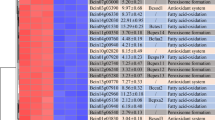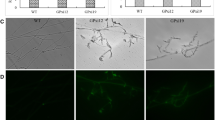Abstract
Expression profiles of isocitrate lyase (TbICL), malate synthase (TbMLS) and fructose-1,6-bisphosphatase (TbFBP) from the mycorrhizal ascomycete Tuber borchii were investigated by real-time RT-PCR in fruiting bodies at different stages of maturation. In addition, a time course experiment was set up to determine how the transcription profile of TbICL, TbMLS and TbFBP in axenic-grown mycelia is affected by different carbon sources. The transcript levels of the three genes in the fruiting bodies were all much higher than those measured in the vegetative stage. The investigation on axenic-grown mycelia revealed that the main positive regulator of TbICL and TbMLS gene expression is the availability of acetate and ethanol, while oleic acid is a too complex substrate for the limited degradative capacities of T. borchii. Immunolabelling on axenic-grown mycelia showed a co-localization of TbICL and the peroxisomal marker protein FOX2. This result demonstrated that in T. borchii ICL is compartmentalized in peroxisomes. The high induction of TbICL, TbMLS and TbFBP transcription and the translocation of lipids in fruiting bodies let us hypothesize that glyoxylate cycle and gluconeogenesis are key metabolic pathways in the recycling of existing cell material and the channelling towards the biosynthesis of new cell components during the maturation of fruiting bodies.





Similar content being viewed by others
Abbreviations
- GLOX:
-
Glyoxylate
- ICL:
-
Isocitrate lyase
- MLS:
-
Malate synthase
- FBP:
-
Fructose -1, 6- bisphosphatase
- EST:
-
Expressed sequence tag
- CM:
-
Control medium
References
Agostini D, Polidori E, Palma F, Ceccaroli P, Saltarelli R, Tonelli D, Stocchi V (2001) Cloning, expression, and characterization of the hxk-1 gene from the white truffle Tuber borchii Vittad.: a first step toward understanding sugar metabolism. Fungal Genet Biol 33:15–23
Aign V, Hoheisel JD (2003) Analysis of nutrient-dependent transcript variations in Neurospora crassa. Fungal Genet Biol 40:225–233
Altschul SF, Madden TL, Schaffer AA, Zhang JH, Zhang Z, Miller W, Lipman DJ (1997) Gapped BLAST and PSI-BLAST: a new generation of protein database search programs. Nucleic Acids Res 25:3389–3402
Amor C, Dominguez AI, De Lucas JR, Laborda F (2000) The catabolite inactivation of Aspergillus nidulans isocitrate lyase occurs by specific autophagy of peroxisomes. Arch Microbiol 174:59–66
Asakura M, Okuno T, Takano Y (2006) Multiple contributions of peroxisomal metabolic function to fungal pathogenicity in Colletotrichum lagenarium. Appl Environ Microbiol 72:6345–6354
Balasubramanian S, Kim SJ, Podila GK (2002) Differential expression of a malate synthase gene during the preinfection stage of symbiosis in the ectomycorrhizal fungus Laccaria bicolor. New Phytol 154:517–527
Balestrini R, Hahn MG, Bonfante P (1996) Location of cell-wall components in ectomycorrhizae of Corylus avellana and Tuber magnatum. Protoplasma 191:55–69
Behari R, Baker A (1993) The carboxyl terminus of isocitrate lyase is not essential for import into glyoxysomes in an in vitro system. J Biol Chem 268:7315–7322
Berardi E, Gambini A, Bellu AR (2003) ALG2, the Hansenula polymorpha isocitrate lyase gene. Yeast 20:803–811
Bonnet C, Espagne E, Zickler D, Boisnard S, Bourdais A, Berteaux-Lecellier V (2006) The peroxisomal import proteins PEX2, PEX5 and PEX7 are differently involved in Podospora anserina sexual cycle. Mol Microbiol 62:57–169
Bowyer P, DeLucas JR, Turner G (1994) Regulation of the Expression of the Isocitrate Lyase Gene (acuD) of Aspergillus nidulans. Mol Gen Genetics 242:484–489
Casselton PJ, Fawole MO, Casselton LA (1969) Isocitrate lyase in Coprinus lagopus (sensu Buller). Can J Microbiol 15:605–608
Ceccaroli P, Saltarelli R, Cesari P, Zambonelli A, Stocchi V (2001) Effects of different carboyhydrate sources on the growth of Tuber borchii Vittad. mycelium strains in pure culture. Mol Cell Biochem 218:65–70
Ceccaroli P, Saltarelli R, Cesari P, Pierleoni R, Sacconi C, Vallorani L, Rubini P, Stocchi V, Martin F (2003) Carbohydrate and amino acid metabolism in Tuber borchii mycelium during glucose utilization: a C-13 NMR study. Fungal Genet Biol 39:168–175
Chaves RS, Herrero P, Ordiz Ingeles del Brio M, Moreno F (1997) Isocitrate lyase localisation in Saccharomyces cerevisiae cells. Gene 198:165–169
Cotter DA, Laclave AJ, Wegener WS, Niederpruem DJ (1970) CO2 control of fruiting in Schizophyllum commune: non involvement of sustained isocitrate lyase depression. Can J Microbiol 16:605–608
De Lucas JR, Amor C, Diaz M, Turner G, Laborda F (1997) Purification and properties of isocitrate lyase from Aspergillus nidulans, a model enzyme to study catabolite inactivation in filamentous fungi. Mycol Res 101:410–414
Ebel F, Schwienbacher M, Beyer J, Heesemann J, Brakhage AA, Brock M (2006) Analysis of the regulation, expression, and localisation of the isocitrate lyase from Aspergillus fumigatus, a potential target for antifungal drug development. Fungal Genet Biol 43:476–489
Emanuelsson O, Elofsson A, von Heijne G, Cristobal S (2003) In silico prediction of the peroxisomal proteome in fungi, plants and animals. J Mol Biol 330:443–456
Eschrich D, Kotter P, Entian KD (2002) Gluconeogenesis in Candida albicans. FEMS Yeast Res 2:315–325
Fossa A, Beyer A, Pfitzner E, Wenzel B, Kunau WH (1995) Molecular cloning, sequencing and sequence analysis of the fox-2 gene of Neurospora crassa encoding the multifunctional beta-oxidation protein. Mol Gen Genet 247:95–104
Gabella S, Abba’ S, Duplessis S, Montanini B, Martin F, Bonfante P (2005) Transcript profiling reveals novel marker genes involved in fruit body formation in Tuber borchii. Eukaryot Cell 5:1599–1602
Gainey DS, Connerton IF, Lewis EH, Turner G, Ballance DJ (1992) Characterization of the glyoxysomal isocitrate lyase genes of Aspergillus nidulans (acuD) and Neurospora crassa (acu-3). Curr Genet 21:43–47
Gould SJ, Keller GA, Hosken N, Wilkinson J, Subramani S (1989) A conserved tripeptide sorts proteins to peroxisomes. J Cell Biol 108:1657–1664
Graham IA, Denby KJ, Leaver CJ (1994) Carbon catabolite repression regulates glyoxylate cycle gene expression in cucumber. Plant Cell 6:761–772
Hedges D, Proft M, Entian KD (1995) CAT8, a new zinc cluster-encoding gene necessary for derepression of gluconeogenic enzymes in the yeast Saccharomyces cerevisiae. Mol Cell Biol 15:1915–1922
Idnurm A, Howlett BJ (2002) Isocitrate lyase is essential for pathogenicity of the fungus Leptosphaeria maculans to canola (Brassica napus). Eukaryot Cell 1:719–724
Kües U, Liu Y (2000) Fruiting body production in basidiomycetes. Appl Microbiol Biotechnol 54:141–152
Kunze M, Kragler F, Binder M, Hartig A, Gurvitz A (2002) Targeting of malate synthase 1 to the peroxisomes of Saccharomyces cerevisiae cells depends on growth on oleic acid medium. Eur J Biochem 269:915–922
Kunze M, Pracharoenwattana I, Smith SM, Hartig A (2006) A central role for the peroxisomal membrane in glyoxylate cycle function. Biochem Biophys Acta Mol Cell Res 1763:1441–1452
Lacourt I, Duplessis S, Abba S, Bonfante P, Martin F (2002) Isolation and characterization of differentially expressed genes in the mycelium and fruit body of Tuber borchii. Appl Environ Microbiol 68:4574–4582
Laemmli UK (1970) Cleavage of structural proteins during the assembly of the head of bacteriophage T4. Nature 227:680–685
Lammers PJ, Jun J, Abubaker J, Arreola R, Gopalan A, Bago B, Hernandez-Sebastia C, Allen JW, Douds DD, Pfeffer PE, Shachar-Hill Y (2001) The glyoxylate cycle in an arbuscular mycorrhizal fungus. Carbon flux and gene expression. Plant Physiol 127:1287–1298
Lopez ML, Redruello B, Valdes E, Moreno F, Heinisch JJ, Rodicio R (2004) Isocitrate lyase of the yeast Kluyveromyces lactis is subject to glucose repression but not to catabolite inactivation. Curr Genet 44:305–316
Lumini E, Bianciotto V, Jargeat P, Novero M, Salvioli A, Faccio A, Becard G, Bonfante P (2007) Presymbiotic growth and sporal morphology are affected in the arbuscular mycorrhizal fungus Gigaspora margarita cured of its endobacteria. Cell Microbiol 9:1716–1729
Miozzi L, Balestrini R, Bolchi A, Novero M, Ottonello S, Bonfante P (2005) Phospholipase A(2) up-regulation during mycorrhiza formation in Tuber borchii. New Phytol 167:229–238
Mogensen J, Nielsen HB, Hofmann G, Nielsen J (2006) Transcription analysis using high-density micro-arrays of Aspergillus nidulans wild-type and CreA mutant during growth on glucose or ethanol. Fungal Genet Biol 43:593–603
Montanini B, Betti M, Marquez AJ, Balestrini R, Bonfante P, Ottonello S (2003) Distinctive properties and expression profiles of glutamine synthetase from a plant symbiotic fungus. Biochem J 373:357–368
Moore D, Ewaze JO (1976) Activities of some enzymes involved in metabolism of carbohydrate during sporophore development in Coprinus cinereus. J Gen Microbiol 97:313–322
Neuberger G, Maurer-Stroh S, Eisenhaber B, Hartig A, Eisenhaber F (2003) Motif refinement of the peroxisomal targeting signal 1 and evaluation of taxon-specific differences. J Mol Biol 328:567–579
Polidori E, Saltarelli R, Ceccaroli P, Buffalini M, Pierleoni R, Palma F, Bonfante P, Stocchi V (2004) Enolase from the ectomycorrhizal fungus Tuber borchii Vittad.: biochemical characterization, molecular cloning, and localization. Fungal Genet Biol 41:157–167
Polidori E, Ceccaroli P, Saltarelli R, Guescini M, Menotta M, Agostini D, Palma F, Stocchi V (2007) Hexose uptake in the plant symbiotic ascomycete Tuber borchii Vittadini: biochemical features and expression pattern of the transporter TBHXT1. Fungal Genet Biol 44:187–198
Riera M, Figueras M, Lopez C, Goday A, Pages M (2004) Protein kinase CK2 modulates developmental functions of the abscisic acid responsive protein Rab17 from maize. Proc Natl Acad Sci USA 101:9879–9884
Ririe KM, Rasmussen RP, Wittwer CT (1997) Product differentiation by analysis of DNA melting curves during the polymerase chain reaction. Anal Biochem 245:154–160
Saltarelli R, Ceccaroli P, Vallorani L, Zambonelli A, Citterio B, Malatesta M, Stocchi V (1998) Biochemical and morphological modifications during the growth of Tuber borchii mycelium. Mycol Res 102:403–409
Smith SM (2002) Does the glyoxylate cycle have an anaplerotic function in plants? Trends Plant Sci 7:12–13
Smith JJ, Brown TW, Eitzen GA, Rachubinski RA (2000) Regulation of peroxisome size and number by fatty acid beta-oxidation in the yeast Yarrowia lipolytica. J Biol Chem 275:20168–20178
Solomon PS, Lee RC, Wilson TJG, Oliver RP (2004) Pathogenicity of Stagonospora nodorum requires malate synthase. Mol Microb 53:1065–1073
Soragni E, Bolchi A, Balestrini R, Gambaretto C, Percudani R, Bonfante P, Ottonello S (2001) A nutrient-regulated, dual localization phospholipase A2 in the symbiotic fungus Tuber borchii. EMBO J 20:5079–5090
Sulter GJ, Waterham HR, Goodman JM, Veenhuis M (1990) Proliferation and metabolic significance of peroxisomes in Candida boidinii during growth on deuterium-alanine or oleic-acid as the sole carbon source. Arch Microbiol 153:485–489
Sweigard JA, Carroll AM, Farrall L, Chumley FG, Valent B (1998) Magnaporthe grisea pathogenicity genes obtained through insertional mutagenesis. Mol Plant Microbe Interact 11:404–412
Valenciano S, DeLucas JR, Pedregosa A, Monistrol IF, Laborda F (1996) Induction of beta-oxidation enzymes and microbody proliferation in Aspergillus nidulans. Arch Microbiol 166:336–341
Valenciano S, De Lucas JR, Van der Klei I, Veenhuis M, Laborda F (1998) Characterization of Aspergillus nidulans peroxisomes by electron immunocytochemistry. Arch Microbiol 170:370–376
Viotti A, Abildsten D, Pogna N, Sala E, Pirrotta V (1982) Multiplicity and diversity of cloned zein cDNA sequences and their chromosomal localization. EMBO J 1:53–58
Wang ZY, Thornton CR, Kershaw MJ, Li DB, Talbot NJ (2003) The glyoxylate cycle is required for temporal regulation of virulence by the plant pathogenic fungus Magnaporthe grisea. Mol Microbiol 47:1601–1612
Winer J, Jung CK, Shackel I, Williams PM (1999) Development and validation of Real-Time quantitative reverse transcriptase-polymerase chain reaction for monitoring gene expression in cardiac myocytesin vitro. Anal Biochem 270:41–49
Yoon JJ, Hattori T, Shimada M (2002) A metabolic role of the glyoxylate and tricarboxylic acid cycles for development of the copper-tolerant brown-rot fungus Fomitopsis palustris. FEMS Microbiol Lett 217:9–14
Acknowledgments
This work was supported by grants from the Regione Piemonte (CIPE B63), IPP-CNR, Compagnia di San Paolo and CEBIOVEM (D.M. 17/10/2003 prot. n. 193/2003). The authors would like to thank Marta Vallino, Luisa Lanfranco, Gilda Cappellazzo and Laura Miozzi (Dipartimento di Biologia Vegetale dell’Università di Torino, Italy) for the helpful discussions about Real-Time RT-PCR data handling and Andrea Genre (Laboratory of Advanced Microscopy) for the support during confocal observations.
Author information
Authors and Affiliations
Corresponding author
Additional information
Communicated by U. Kües.
Simona Abba’ and Raffaella Balestrini contributed equally to this work.
Electronic supplementary material
Below is the link to the electronic supplementary material.
Rights and permissions
About this article
Cite this article
Abba’, S., Balestrini, R., Benedetto, A. et al. The role of the glyoxylate cycle in the symbiotic fungus Tuber borchii: expression analysis and subcellular localization. Curr Genet 52, 159–170 (2007). https://doi.org/10.1007/s00294-007-0149-7
Received:
Revised:
Accepted:
Published:
Issue Date:
DOI: https://doi.org/10.1007/s00294-007-0149-7




